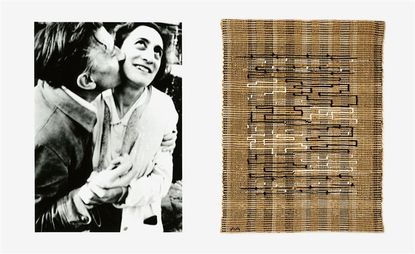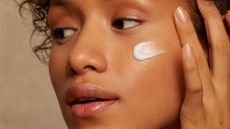The multifaceted influence of Anni and Josef Albers on fashion

‘Anni Albers avoided defining herself in narrow terms and was constantly innovating and exploring new avenues for creating art,’ says Lucy Weber, director of Albers by Design at the Josef and Anni Albers Foundation. The extensive and experimental output of the Bauhaus pioneer is currently on display at the Tate Modern, as part of a seminal retrospective, spanning everything from the creative studies in colour and pattern she produced while studying at the German school, her commercial and function-led creations and her art-focused small-scale ‘pictorial weavings'.
Annie Fleischmann joined the Bauhaus school in 1922, and went on to marry her teacher Josef Albers in 1925, shortly after her arrival in Weimar. Both went on to become leading pioneers in 20th-century modernism, and the duo are renowned for their output in painting, colour theory, textile design and weaving. Josef published his artist’s handbook Interaction of Color in 1963, and Anni released her seminal text On Weaving in 1965.
A collaborative spirit was at the centre of the Bauhaus philosophy, and it’s particularly pertinent that this spirit of partnership has continued after the Albers’ death, in the form of capsule collections between fashion designers and the Josef and Anni Albers Foundation.
‘In many instances, Anni has left us a perfect road map for creating new objects, from rugs, to blankets, to wallpaper and upholstery materials,' Weber says. ‘I have also noticed that designers are drawn to the order and precision of Josef’s work, as well as to his use of colour.’
Here, we discover what draws Hermès, Paul Smith and Roksanda to the work of the two modernist masters…
Hermès

‘Albers’ principle was a simple one: to create a series of infinite chromatic variations within an unchanging form: the square, composed in a certain way,’ says Hermès’ artistic director Pierre-Alexis Dumas. In the Parisian maison’s 2008 collaboration with the Josef and Anni Albers Foundation, Dumas and women’s universe creative director Bali Barret, travelled to its home in Bethany, Connecticut, to view pieces in Josef’s ‘Homage to the Square’ series.
What resulted was a series of tonal silk scarves – the first in Hermès’ ‘Editeur’ series, which has also seen collaborations with Daniel Buren, Hiroshi Sugimoto and Julio Le Parc – evoking the square variations of colour in Albers’ artworks. ‘They took us to the limits of our savoir-faire,’ Dumas adds. ‘The technique is “frame” printing, but at its most challenging, involving the feat known as “edge to edge,” in which large swathes of colour have to be printed on the silks, so that they touch each other but do not overlap.’

Left, Wallhanging, by Anni Albers, 1925, Collection Die Neue Sammlung, Munich.
Paul Smith
‘Following a bad cycling accident, I started hanging out in a local pub, in Nottingham, meeting up with students from the local art college when I was there. They told me about this thing called “Bauhaus” and at first I thought it was a council estate but I soon learnt otherwise!’ laughs Paul Smith. ‘It was during one of those conversations that I first heard mention of Anni and became aware of her work.’
In celebration of the Tate Modern’s recently opened Albers retrospective, Smith has designed a men’s and women’s Scottish cashmere jumper, scarf and blanket inspired by a colourful and graphic and untitled wallhanging from 1925. Smith’s A/W 2015 collection – which featured garments panelled in graphic squares of colour, also nods to the tonal gradation in Josef and Anni Albers’ work – took its cues from the couple's research trips to Mexico.
‘I’m most inspired by Anni’s very experimental and pioneering approach to using unexpected materials and fibres,' Smith says. ‘She’d weave a piece of plastic or rayon in the most unlikely of places. She was a true visionary.'
Roksanda

Roksanda's collaboration with the Josef and Anni Albers Foundation debuted during Frieze Art Far in London in 2013
‘Josef Albers really showed how different colours can look completely different in various combinations,’ says Roksanda Ilinčić, who collaborated with the Josef and Anni Albers Foundation in 2013, on an eight-piece capsule collection, which also celebrated the opening of her Mount Street boutique in London. The designer is renowned for her prowess and agility with colour, and this offering of dresses and separates, was colour-blocked into distinct panels. The pieces looked to the colour theory of Josef Albers’ ‘Homage to the Square’ series, and nodded to particular works like the Homage to the Square (La Tehuana) (1951) and Homage to the Square (1965).
Anni Albers’ work permeates her aesthetic. ‘I’ve also always been drawn to her status as a woman within Bauhaus. Women were expected to work on weaving and tapestry, but she tore up the perception that applied arts categories can’t be worthy of our admiration or high status. Josef and Anni are people that I come back to again and again.’

Left, Palatial by Josef Albers, from the portfolio ‘Soft Edge–Hard Edge'.

Left, Red Meander ‘pictorial weaving', by Anni Albers, 1954. Right, Anni Albers with textile samples in her home, New Haven, ca. 1950–60.
INFORMATION
‘Anni Albers’ is on view until 27 January 2019. For more information visit the Tate Modern website; Albers Foundation website, Hermès website, Paul Smith website, Roksanda website
Wallpaper* Newsletter
Receive our daily digest of inspiration, escapism and design stories from around the world direct to your inbox.
ADDRESS
Tate Modern
Bankside
London
SE1 9TG
-
 RIBA House of the Year 2024: browse the shortlist and pick your favourite
RIBA House of the Year 2024: browse the shortlist and pick your favouriteThe RIBA House of the Year 2024 shortlist is out, celebrating homes across the UK: it's time to place your bets. Which will win the top gong?
By Ellie Stathaki Published
-
 The Nothing Phone (2a) Plus Community Edition taps into the brand's creative followers
The Nothing Phone (2a) Plus Community Edition taps into the brand's creative followersThe unconventional features of Nothing Phone (2a)’s new limited edition come from a community-driven project to reshape the style and ethos of the smartphone
By Jonathan Bell Published
-
 What is the sound of Stone Island? A new musical project helps you find out
What is the sound of Stone Island? A new musical project helps you find outStone Island Sound is a new, evolving music project from the Italian label, seeing contributions from John Glacier, Yaeji and more across playlists and live performances
By Jack Moss Published
-
 Hermès Beauty’s eye and lip pencils invite playfulness with colour and texture
Hermès Beauty’s eye and lip pencils invite playfulness with colour and textureHermès Beauty’s creative director Gregoris Pyrpylis has added to the ‘Trait d’Hermès’ collection with a set of eye and lip liners in kaleidoscopic colours. Here, he speaks to Wallpaper* about their playful design
By Hannah Tindle Published
-
 The story behind Hermès’ ‘Barénia’, a perfume that took nearly ten years to make
The story behind Hermès’ ‘Barénia’, a perfume that took nearly ten years to makeHermès’ ‘Barénia’ is the house’s first-ever chypre fragrance. Christine Nagel tells Wallpaper* why it was almost ten years in the making
By Hannah Tindle Published
-
 Sourcewhere is the app helping you find the rarest fashion grails
Sourcewhere is the app helping you find the rarest fashion grailsSourcewhere uses a network of experts and personal shoppers to source rare vintage and limited-edition fashion, from Phoebe Philo’s Céline to Margiela-era Hermès. Here, founder Erica Wright tells Wallpaper* why it’s reflecting a wider change in the way people shop luxury fashion
By Mary Cleary Published
-
 Why solid soap is the most pleasurable object to bathe with
Why solid soap is the most pleasurable object to bathe withSolid soap provides a tactile bathing experience like no other. Hannah Tindle explores why in the September 2024 Style Issue of Wallpaper*, with soaps by Chanel, Celine, Diptyque, and more, photographed by Sophie Gladstone
By Hannah Tindle Published
-
 The best sunscreens for your face, selected by the Wallpaper* beauty editors
The best sunscreens for your face, selected by the Wallpaper* beauty editorsThis list of the best sunscreens for your face has been compiled by Wallpaper* editors Mary Cleary and Hannah Tindle, who are highly selective about SPF
By Mary Cleary Published
-
 ’What is the life of a woman?’: Nadège Vanhée on a decade of womenswear at Hermès
’What is the life of a woman?’: Nadège Vanhée on a decade of womenswear at HermèsFor the past ten years, Nadège Vanhée, head of womenswear at Hermès, has steered the French maison on a quietly rebellious path, exploring notions of contemplation, liberation and sensuality. Speaking to fashion features editor Jack Moss, she unpacks her evolution
By Jack Moss Published
-
 Wallpaper* September 2024, The Style Issue, is on newsstands now: discover the looks of the season
Wallpaper* September 2024, The Style Issue, is on newsstands now: discover the looks of the seasonWallpaper* September 2024, The Style Issue, heralds sensual dressing for the season ahead. Hear from Dior’s Kim Jones, Hermès’ Nadège Vanhée, and tour Karl Lagerfeld’s bookshop
By Bill Prince Published
-
 Kyoto exhibition collates Veronica Ditting’s influential printed matter for the world’s biggest brands
Kyoto exhibition collates Veronica Ditting’s influential printed matter for the world’s biggest brandsCreative director and designer Veronica Ditting has created printed matter for The Row, Hermès and Maison Margiela. Now, a new exhibition in Kyoto, ‘Folio Folio Folio: Print by Veronica Ditting’ celebrates her influential career so far
By Jack Moss Published